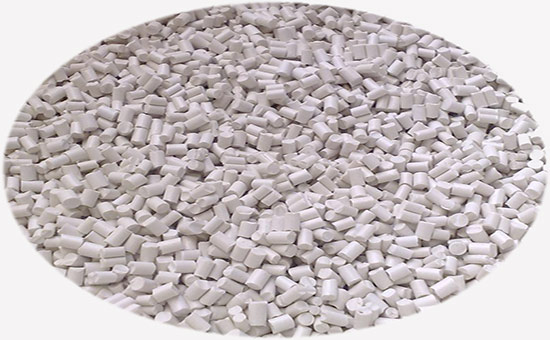
According to the source of waste rubber, rubber powder can be divided into tire tread rubber powder, full tire rubber powder, inner tube rubber powder, nitrile rubber powder, ethylene propylene diene monomer rubber powder, etc; According to polarity, it can be divided into polar rubber powder and non polar rubber powder, with the polar rubber powder mainly composed of nitrile rubber powder. Universal polar resins include polyvinyl chloride resin (PVC), chlorinated polyethylene resin (CPVC), EVA resin, etc. According to the compatibility principle of similar polarity, it is appropriate to use polar rubber powder and polar resin together, while modifying measures are required to use nonpolar rubber powder and polar resin together.
The thermal stability of PVC at high temperatures is not ideal, and its impact resistance is poor. Mixing PVC with rubber powder process can improve its performance shortcomings. In practical production, when PVC and tire rubber powder are modified together, due to the main components of tire rubber powder 2SLY328 being nonpolar natural rubber, cis-1,4-polybutadiene rubber, and styrene butadiene rubber, which have poor compatibility with polar PVC, it is recommended to use compatibilization technology to improve the compatibility of tire rubber powder with PVC and prepare thermoplastic elastomers with good comprehensive performance.
The surface activity of unmodified rubber powder is poor, and it is not easy to combine with other substances. The chlorinated activated rubber powder, through melt blending with PVC, helps to improve the interface bonding with PVC, improve the physical properties of the blend material, and improve the dynamic properties. Moreover, the chlorinated rubber powder and PVC blend exhibit good repeated processing performance. When PVC and rubber are used together, plasma can also be used to modify the surface of rubber powder to improve the adhesive strength among rubber powder and PVC, as well as the mechanical properties of PVC/rubber powder composites.
There are two important conditions for modifying PVC with PVC rubber powder: PVC products are divided into hard PVC (RPVC) and soft PVC (YPVC). When modifying RPVC with rubber powder, it is called toughened modified PVC; The modification of YPVC with rubber powder cannot be called toughening because YPVC does not involve the issue of room temperature toughness. Rubber powder modified YPVC can improve low-temperature brittleness resistance and reduce plastic deformation.
Rubber powder can also modify chlorinated polyethylene resin. When CPVC uses rubber powder for toughening modification, the strength and heat resistance of the blend material are reduced, and attention should be paid to the proportion of rubber powder added. Polar rubber powder or polar modified rubber powder can be used together with EVA resin, and can generally be mixed with EVA in any proportion.
In actual production, rubber powder can be used not only with general-purpose polar resins, but also with general-purpose polyolefin resins (PE resin, PP resin, PS resin), general-purpose engineering resins, etc. The editor will continue to discuss relevant issues with you.
Exclusive original article [commercial authorization] reprint, excerpt and excerpt in any form are prohibited without written authorization. Focus on Hongyun rubber: learn the process formula and raw material technology of producing rubber products from recycled rubber to help you reduce costs and increase profits